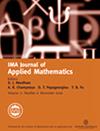曲率效应与径向同宿蛇形
IF 1.4
4区 数学
Q2 MATHEMATICS, APPLIED
引用次数: 3
摘要
在这项工作中,我们回顾了二维(2D)中均匀状态和局部结构形成之间的圆形锋面动力学的一些一般结果。我们展示了在半径局部化的轴对称结构的分岔图如何在塌缩同斜蛇形框架内拟合。在二维中,由于曲率效应,蛇形结构的坍塌遵循由所谓的成核半径决定的不同尺度。此外,在两个对称相关状态之间的前沿的情况下,径向蛇形坍缩在参数空间中的精确点不是“麦克斯韦”点,而是仅由曲率驱动的动力学决定的。在这种情况下,蛇形收缩到“零表面张力”点。在这一点附近,齐次状态之间对称性的破坏使蛇形图倾斜。在每种情况下,对于蛇形曲线的崩塌,都发现了不同的标度定律。曲率对具有内部结构的轴对称局域状态的影响也进行了讨论,同样也讨论了由圆形前缘与均匀状态分离的细胞结构。虽然其中一些结果在曲率驱动动力学和锋面相互作用方面得到了很好的理解,但在径向空间动力学描述中缺乏关于同斜轨迹的适当数学描述。本文章由计算机程序翻译,如有差异,请以英文原文为准。
Curvature effects and radial homoclinic snaking
In this work, we revisit some general results on the dynamics of circular fronts between homogeneous states and the formation of localized structures in two dimensions (2D). We show how the bifurcation diagram of axisymmetric structures localized in radius fits within the framework of collapsed homoclinic snaking. In 2D, owing to curvature effects, the collapse of the snaking structure follows a different scaling that is determined by the so-called nucleation radius. Moreover, in the case of fronts between two symmetry-related states, the precise point in parameter space to which radial snaking collapses is not a ‘Maxwell’ point but is determined by the curvature-driven dynamics only. In this case, the snaking collapses to a ‘zero surface tension’ point. Near this point, the breaking of symmetry between the homogeneous states tilts the snaking diagram. A different scaling law is found for the collapse of the snaking curve in each case. Curvature effects on axisymmetric localized states with internal structure are also discussed, as are cellular structures separated from a homogeneous state by a circular front. While some of these results are well understood in terms of curvature-driven dynamics and front interactions, a proper mathematical description in terms of homoclinic trajectories in a radial spatial dynamics description is lacking.
求助全文
通过发布文献求助,成功后即可免费获取论文全文。
去求助
来源期刊
CiteScore
2.30
自引率
8.30%
发文量
32
审稿时长
24 months
期刊介绍:
The IMA Journal of Applied Mathematics is a direct successor of the Journal of the Institute of Mathematics and its Applications which was started in 1965. It is an interdisciplinary journal that publishes research on mathematics arising in the physical sciences and engineering as well as suitable articles in the life sciences, social sciences, and finance. Submissions should address interesting and challenging mathematical problems arising in applications. A good balance between the development of the application(s) and the analysis is expected. Papers that either use established methods to address solved problems or that present analysis in the absence of applications will not be considered.
The journal welcomes submissions in many research areas. Examples are: continuum mechanics materials science and elasticity, including boundary layer theory, combustion, complex flows and soft matter, electrohydrodynamics and magnetohydrodynamics, geophysical flows, granular flows, interfacial and free surface flows, vortex dynamics; elasticity theory; linear and nonlinear wave propagation, nonlinear optics and photonics; inverse problems; applied dynamical systems and nonlinear systems; mathematical physics; stochastic differential equations and stochastic dynamics; network science; industrial applications.

 求助内容:
求助内容: 应助结果提醒方式:
应助结果提醒方式:


